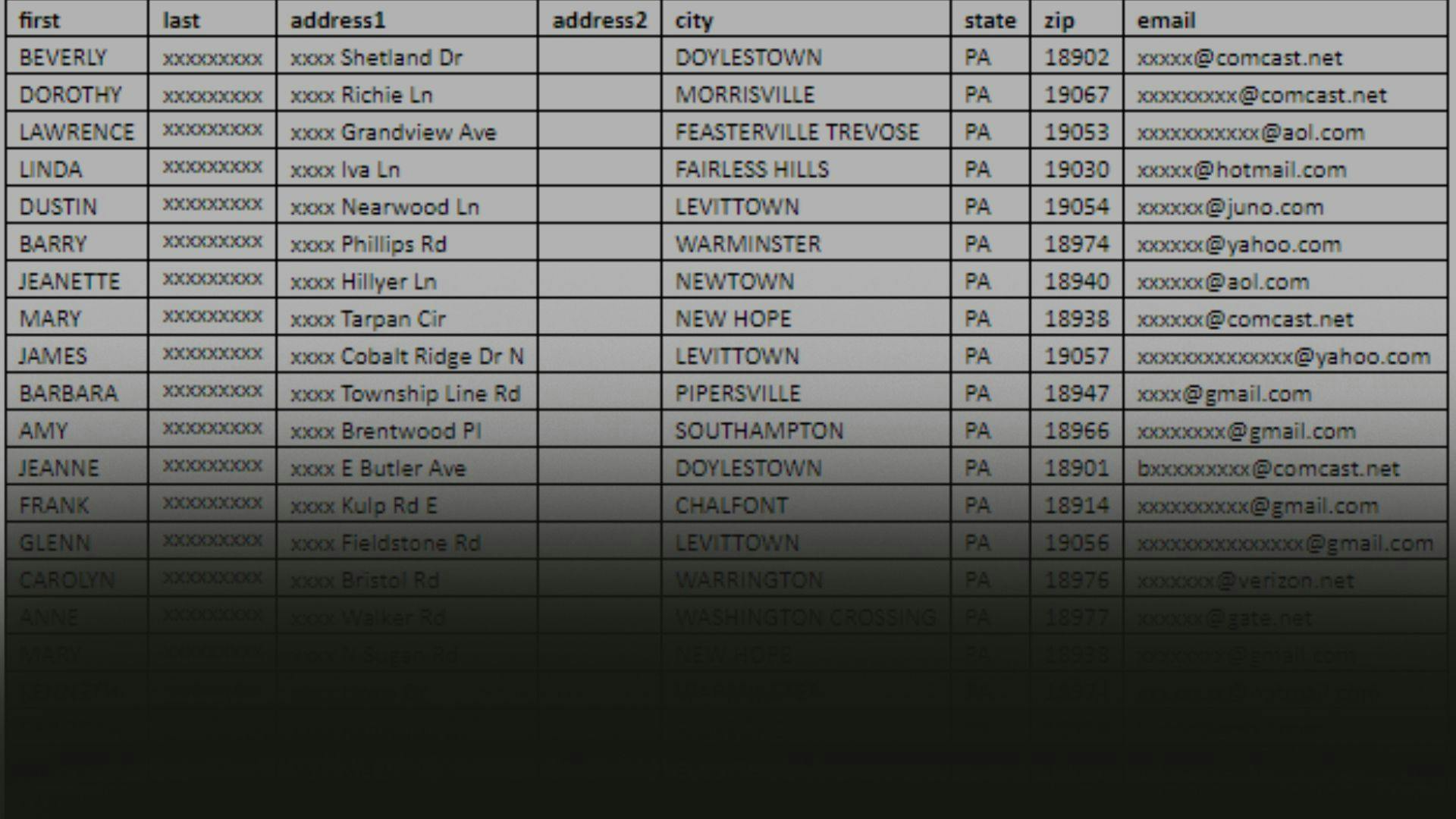13 Tactics To Build An Email List Without Paid Ads
1. Content Upgrades
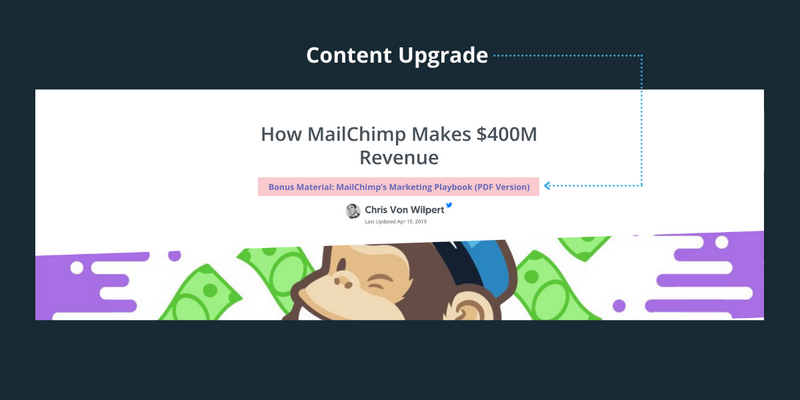
Content upgrades are a frictionless and unintrusive way to convert traffic into either leads or downright building your email list.
A content upgrade is where you create additional content on the backend of an article/blog post and offer an “upgrade” via email — usually in the form of bonus content.
Example:
AppSumo utilizes content upgrades to drive leads for both Sumo and AppSumo.
Currently, it drives 10,000 leads a month via its SEO loop.
And they do this simply by publishing 85% of the article for free on their blog and then offering the remaining 15% via email after someone opts in.
Content upgrades are best used when your SEO efforts are consistently driving traffic to your blog and also if you have a catalog of blog posts.
To start, I’d take the top-performing articles and start adding content upgrades to test their effectiveness.
And scale if it drives results.
This is an effective tactic for both SaaS companies and media companies.
It can be used to drive leads for your SaaS or to grow your email list for your media company.
Example:
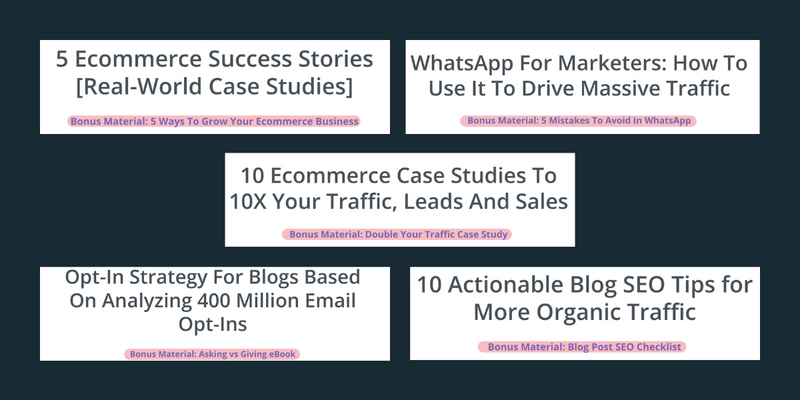
In the upcoming weeks, you’ll see me implementing this on my blog.
And I’ll update you with the results.
2. Free Courses
What is it: We’re all well aware of creators creating courses around specific topics. But an underutilized tactic for companies is to create free courses on the backend of your customer's most frequently asked questions. Not only is it an effective way to build your email list but also a positioning play. Just like creators position themself as leaders within a category, businesses can use courses to position themselves as the guide.
This is something we do at Gumroad. We take frequently asked questions from creators and ship free courses based on those questions. Not only does it help us build our email list, but it helps build authority and trust among creators.
Example: Gumroad
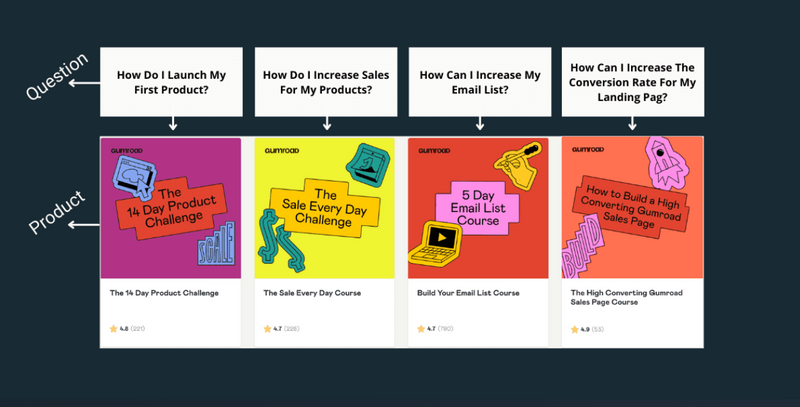
Free courses are best used when you’ve collected customer feedback, pain points, frequently asked questions, and found a common theme in the data. This data is then used to create courses that will address these pain points and questions for future customers.
Here’s an effective way to drive traffic to these courses:
- Collect customer pain points
- Collect frequently asked questions
- Create an SEO optimized blog post answering these questions
- Create free courses around these subjects
- Link to the free courses in these blog posts
Here’s how Ahrefs does it:
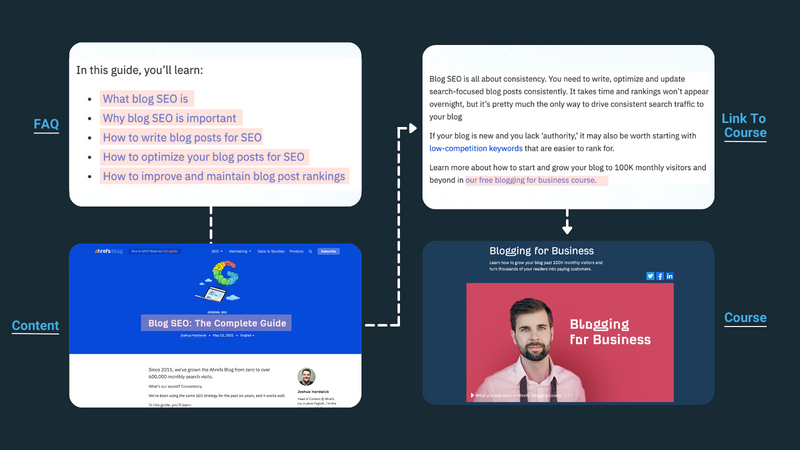
3. Free Email Drips
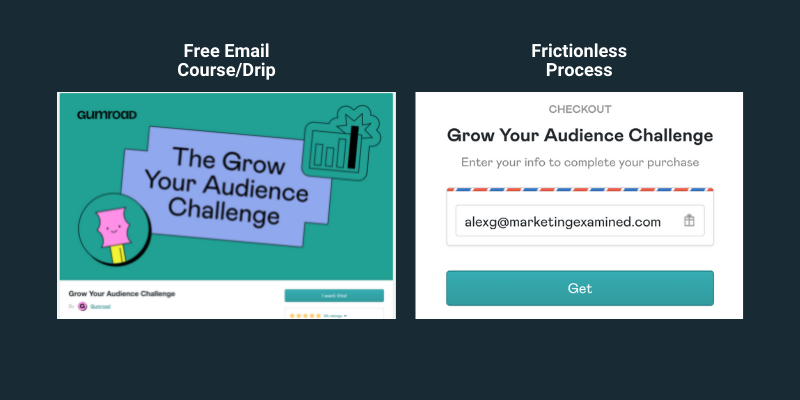
What is it: Similar to a free course, an email drip series is another way to deliver content on the backend of customer pain points and frequently asked questions. Unlike courses, with an email drip series, you can ship the MVP much faster than a polished course. Similar to the courses, this is something we do at Gumroad too, and we found much success using this as a lead-generation tool.
Here’s how to create an effective email drip series:
- Collect the customer pain points and FAQ
- Select a topic to deep-dive
- Break the content into digestible chunks
- Send each chunk of information on a different day
Let’s take this case study for example (this could be applied to the course section as well):
- FAQ = How can I generate leads without paid marketing?
- Topic = How to effectively build your email list without paid marketing
- Digestible Chunks = 7-Day Series
- Day 1 = SEO
- Day 2 = Optimizing Your Blog
- Day 3 = Scaling Your Blog Posts into Courses and Email Drips
- Day 4 = Using quizzes, calculators, and tools to drive and convert cold traffic into leads
- Day 5 = Using social to drive traffic
- Day 6 = How to use communities to drive traffic
- Day 7 = Implementing a referral program
If this was a course, each day would be a different module or chapter.
Email drips are best used when you’re aiming to test a content type fast. Because of the nature of an email drip, you can outline, write, and schedule an email drip series in a day or two. After proven valuable, the email drip series can be scaled into a course.
4. Exit Intent Popups
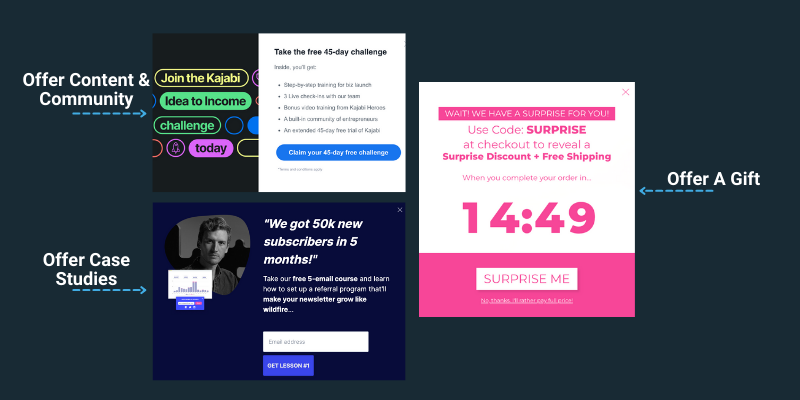
What it is: We’re all aware of an exit-intent popup. Some love them, and some hate them, but truth be told, they’re effective. According to Conversion Sciences, “10 to 15 percent of lost visitors can be 'saved' by using exit-intent popups. Unlike other popups, exit-intent popups don’t distract the user while they’re exploring your site. Instead, they try to reengage the user on the way out.
But different types of businesses should use different types of exit-intent popups.
- Direct to Consumer → Discounts, Free Shipping, Gifts
- Business to Business → Case Studies, Challenges, Community, Content
- Media → Challenges, Community, Content, Case Studies
If you want to maximize your exit-intent popup, then consider using the free courses and/or your email drip series as the lead magnet.
Exit-Intent Popups are best used when your site is generating traffic (either paid or organic), and you have a valuable piece of content that would interest the individual. If not, you’re making a bad first impression.
Also, to create an even higher-converting exit-intent popup, then create the popup specific to the topic they’re searching or reading. This refers to keeping the scent trail the same.
5. Create A Calculator
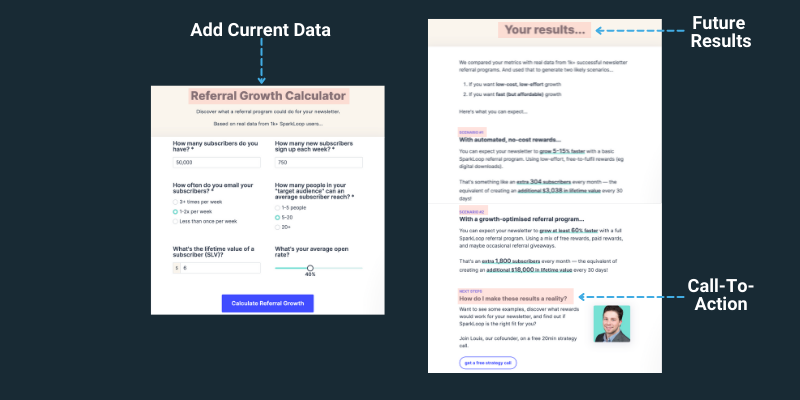
What is it: Calculators are lead generation machines. The most effective calculators are used to give leads a glimpse into the future if they choose to become a customer. They do this by calculating current data and presenting you with the potential results.
The reason they work is because calculators are a bridge into the future. They show customers where they currently are and where they can be.
SparkLoop has done a phenomenal job of this. They created a Referral Growth Calculator (illustrated above) that shows the prospective customer the growth that you’re missing out on. And add a simple call to action to convert leads into customers.
6. Create a Quiz
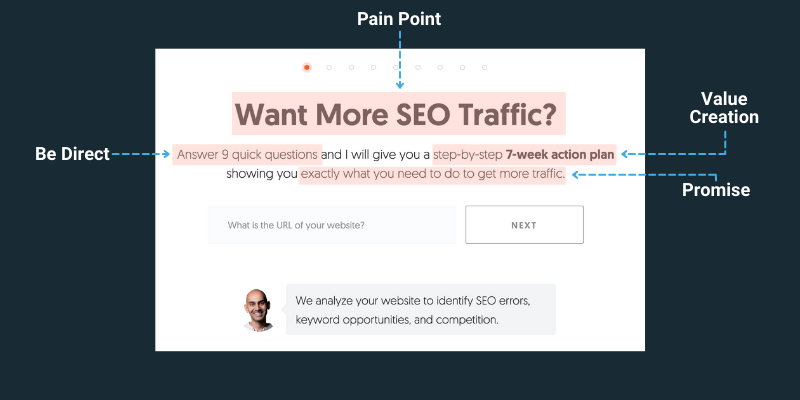
What is it: Quizzes are an interactive form of content where you ask website visitors a series of questions and deliver the results via email. And where calculators give a glimpse into the future, quizzes open the door the personalization. Dependent on the consumer's answers, you can recommend different products or content.
Neil Patel used a quiz to collect 700,000 plus emails and breaks it down here and if you’re looking for a simple software to help you generate quizzes then tap here.
7. Create A Tool

What is it: Similar to a quiz, creating a tool helps you find customer pain points and also opens the door to personalization. The majority of lead generation tools take a small aspect of the actual product (example: Ahrefs or HubSpot) and offer it for free.
In HubSpot’s early days, they created a website grader that lived on their site and blog and was responsible for their first 15,000 users. And Dharmesh, the co-founder of HubSpot says it was a key part of their growth.
8. Implement A Referral Program
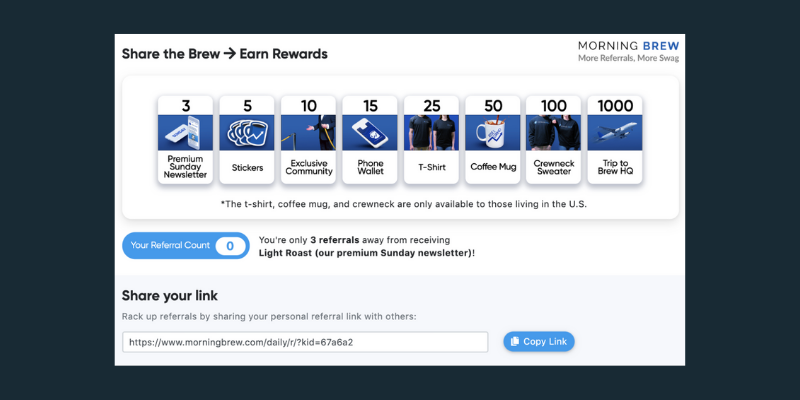
What is it: One of the common denominators in the fastest-growing startups is the use of a referral program. And it’s something every business should integrate into their acquisition loops because it turns your current customers and subscribers into an acquisition channel. That means a lower CAC and a higher LTV.
Referral programs are best used when you have an existing email list
Also, the next Growth Marketing Examined case study will be a HUGE deep dive on how to create an effective referral program.
9. Exchange Ad Slots
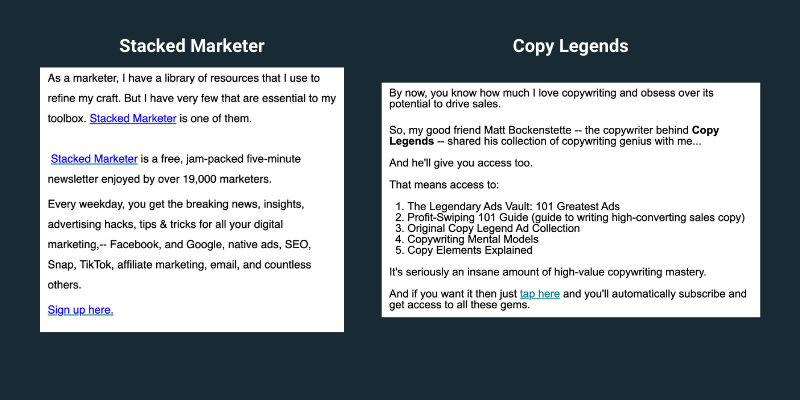
What is it: This is when you partner with other businesses and exchange ad slots in either newsletters, emails, podcasts, or social posts. By doing so, you can get directly in front of your ideal customer by exchanging ad slots with a business who shares an overlap in their demographic. Overlaps in audiences.
For example, at the beginning of Marketing Examined’s days, I was exchanging ad slots with other marketing newsletters with a similar-sized audience to drive new subscribers. All in all, it was a win-win for both parties.
I scaled this by creating an ad slot exchange calendar and scheduled out two months of ad slots. This helped me add thousands of new subscribers.
10. Co-Marketing
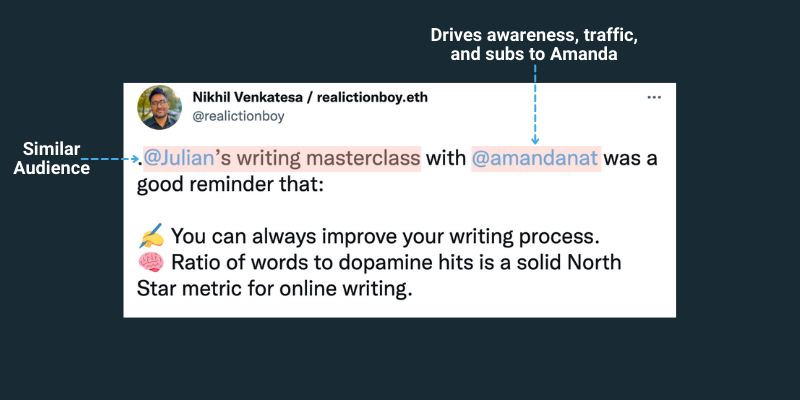
What is it: Similar to exchanging ad slots, collaborating/co-marketing with other businesses or creators is another way to build your email list quickly. You can collaborate by hosting webinars, live chats (spaces, clubhouse, IG, FB), or creating content together (courses, ebooks, guides, etc).
Amanda Natividad, the VP of Marketing for SparkToro, said that when she was trying to grow her email list, she collaborated with businesses and creators via webinars and said that it drove the most growth and helped her surpass 1000 subscribers in two months.
11. Use Twitter’s Revue Bio Integration

What is it: With Twitter acquiring Revue, both businesses, and creators can integrate a newsletter sign-up form into their Twitter bio. This makes signing up for your newsletter or email list just a two-click process. And with Zapier, you can migrate subscribers from Revue to the ESP of your choice.
If you don’t have a newsletter, then you can use the Revue sign-up form to generate leads by using your course, email drips, and free ebooks as the value-creation to signup.
12. Twitter Threads
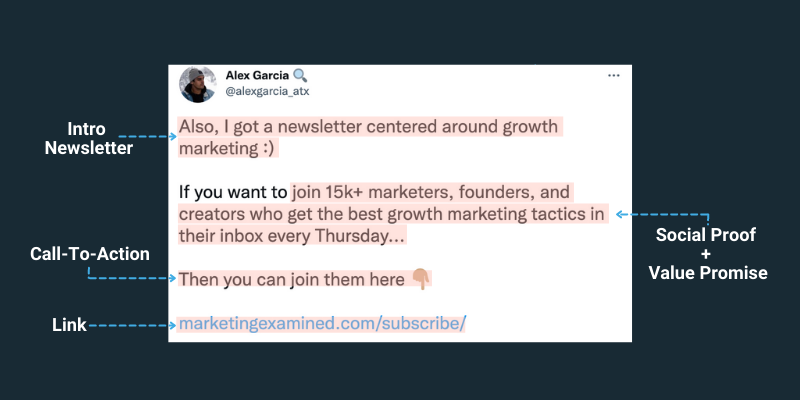
What is it: Twitter threads are social blogs with built-in distribution. They’re also Twitter’s growth content. Meaning the content that Twitter’s algorithm favors. Because of this, they get a higher engagement rate and also do a phenomenal job of converting readers into subscribers which should be a staple in your content marketing strategy.
To execute, take existing blog posts and craft them into Twitter threads. At the end of the Twitter thread, add a call-to-action, a valued reminder, and the specific link you want consumers to visit.
Another great example of using Twitter threads for lead generation was done by Yannick, the Co-Founder of Hypefury.
He wrote a phenomenal thread about SEO that gained traction for 2-3 days and ended with nearly 5000 likes.
The end result was a ton of inbound DMs trying to hire Yannick.
Example:
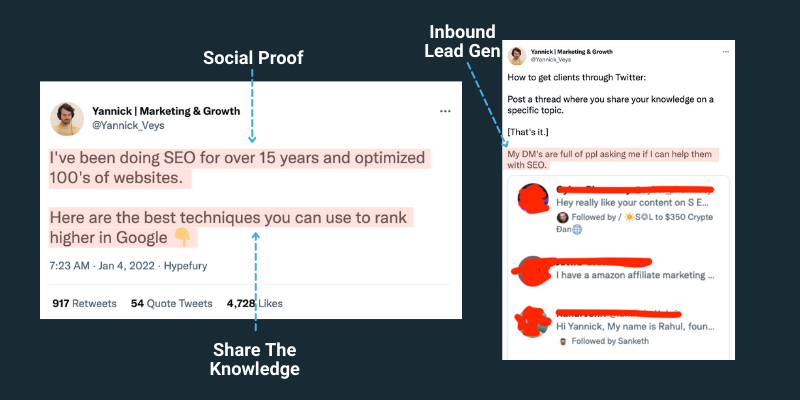
13. Optimize Your Blog Posts
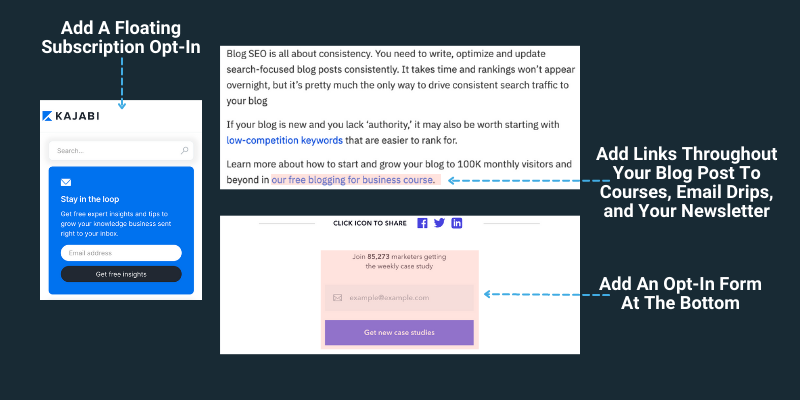
What is it: Most businesses and individuals optimize their blogs for traffic. But I’d argue that most businesses don’t optimize their blogs to convert traffic into leads and subscribers. Because of that all of the attention goes to driving more and more traffic without maximizing how to convert that traffic.
To convert a % of that traffic into subscribers or leads, add:
- A floating subscription opt-in form on the side
- An opt-in form at the bottom of your blog posts for your courses, email drips, or newsletter
- Links throughout your blog posts to your courses, email drips, or newsletter
